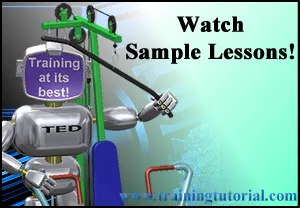Unlock the Power of Inventor Studio!
Once you've mastered the skills taught in the first 5 courses you might want to show others your work. The Inventor 2020-2021: Inventor Studio Made Simple course shows you how it's done. You will learn how to render professional looking images and animations of your parts and assemblies.
Inventor Studio allows you to render images and animations of your parts and assemblies. You can use it to create videos of your assemblies in action, which can be a helpful marketing tool, or it can be used to help others understand how your assemblies are assembled.
You will learn how to produce professionally looking images and videos of your work. You will learn how to setup lighting scenes, create camera views, and the details about rendering images and automated videos.
Need to make a fly through video of your assemblies? This course shows you how it's done. You'll also create custom IBL environments and many other tips and tricks that will help you create professional looking images and videos.
As with all our courses, each step is cover in detail. Even complicated tasks like animating cameras and creating camera and target paths will be a breeze because you see all the steps and get a clear description of how the commands work.
39 Lessons (Listed Below)
3.3 hours of instruction
You can also browse through the lessons from the following Inventor 2020-2021 courses and watch sample lessons.
Inventor 2020-2021: Solid Modeling Inventor 2020-2021: Assemblies and Advanced Concepts Inventor 2020-2021: 2D Drafting and Customization Inventor 2020-2021: Sheet Metal Design Inventor 2020-2021: Tube and Pipe Routed Systems Inventor 2020-2021: Inventor Studio Made Simple Inventor 2020-2021: iLogic Made Simple Inventor 2020-2021: Fea Made Simple Inventor 2020-2021: Dynamic Simulation Made SimpleOur Inventor courses require No Installation. You can watch them on any device connected to the internet.
You will receive an email containing your User Name and Password. Login to your account and start learning. It's that easy.
While you're logged into your account you can download files used in the courses, watch lessons, and practice the tasks taught in the lessons. Keep in mind that you will use your installation of Inventor to practice.
Get your Inventor 2020-2021 training now. You can start learning in minutes.
Autodesk Inventor® 2020-2021:
Inventor Studio Made Simple
No Installation Required
Watch from any device connected to the internet.

$54.95 - $109.95
Watch Sample Lessons
Watch the first hour of the Solid Modeling course for Autodesk Inventor 2020-2021.
 Click to Watch!
Click to Watch!Inventor Studio Made Simple
3.3 hours of instruction
Lessons
Introduction
Assembly Preparation
Introduction to Inventor Studio
Spotlight Settings
Set Ground Plane Orientation
IBL Environments
Custom IBL Environments
JPEG Images in IBL Environments
Point and Directional Lighting
Editing Appearances
Components of Animations
Animation Timeline and Actions
Mirroring and Copying Actions
Custom Animations
Suppress Constraint Animations
Enabling Constraint Animations
Camera Turntables
Camera Paths
Advanced Path Design
View Control Concepts
Custom Cameras
Fly-Through Animations
Analysis of Animation Motion
Animating Lights
Wrapper Assemblies
Local Lights
Publishing Styles
Surface Appearances
From Picture to Surface
Transparency and Reflectivity
Model Turntables
Using Positional Representations
Animating Parameters
Solving Animation Conflicts
Depth of Field
Video Producer
Editing Video Productions
Video Production Strategies
Conclusion
